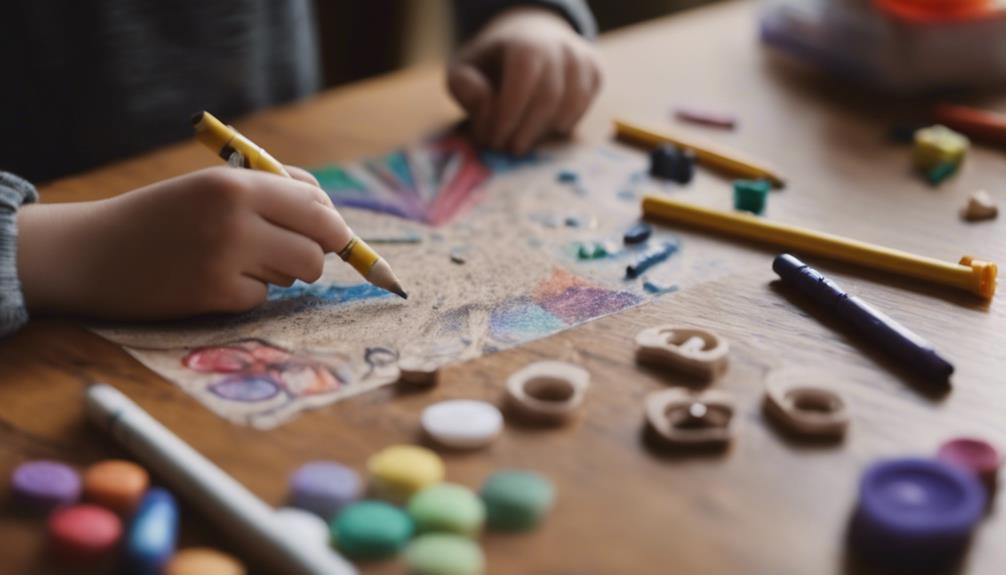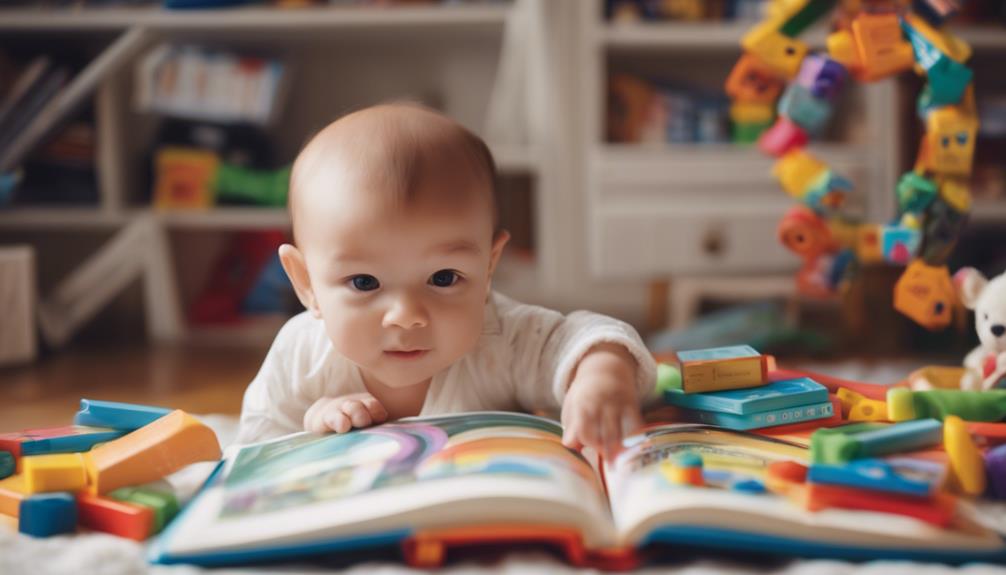To promote early literacy through baby writing, provide washable, chunky crayons and markers for easy gripping. Start by drawing basic shapes at age 2 and progress to representational drawing by age 3. Use a variety of writing tools such as chalk, pencils, and finger paints. Encourage labeling parts of drawings to help associate words with objects. In addition, having a designated writing area can boost regular writing activities. Finally, combining drawings with writing and practicing signing names on drawings can further enhance language and literacy development. These activities establish a solid foundation for your child’s future academic success.
Key Takeaways
- Provide washable, chunky tools for scribbling to develop fine motor skills.
- Model writing behavior to show how letters represent words.
- Engage in drawing activities as a social and bonding experience.
- Encourage labeling drawings to boost language development.
- Offer various writing surfaces and art supplies for a creative writing environment.
Benefits of Baby Writing
Engaging in baby writing activities early on actively promotes your child's literacy development by bridging spoken language with printed words. When you encourage your child to scribble with thick crayons and pencils, you aren't only fostering creativity but also enhancing their fine motor skills. These early writing experiences help children understand that letters represent words, laying a strong foundation for their language development.
By providing various writing surfaces and art supplies, you offer your child the opportunity to practice and enjoy the process of putting their thoughts onto paper.
Moreover, encouraging children to label parts of their drawings further boosts their language development through writing. This simple activity helps them make connections between spoken words and their written forms, fostering a deeper understanding of language. Through these baby writing experiences, your child not only learns to express themselves creatively but also develops essential early literacy skills that will benefit them throughout their academic journey.
Setting the Foundation

To establish a strong foundation for early literacy, focus on developing fine motor skills through writing and drawing activities. These activities play an important role in laying the groundwork for your child's future reading and writing abilities. By engaging in early writing and drawing exercises, children enhance their fine motor skills, which are essential for tasks like holding a pencil correctly and forming letters accurately.
| Activities for Developing Fine Motor Skills |
|---|
| 1. Provide washable and chunky tools for scribbling |
| 2. Model writing behavior for your child |
| 3. Keep safe writing tools accessible |
| 4. Encourage drawing basic shapes by age 2 |
| 5. Support progressing to representational drawing by age 3 |
Engaging in these activities not only aids in the development of fine motor skills but also fosters early writing and creative abilities in children. By incorporating these practices into your child's routine, you are setting a solid foundation for their journey towards literacy.
Materials for Writing Activities

Consider providing a variety of materials to enhance writing activities for young children. When engaging in early language development through writing, offering washable, chunky crayons and markers can facilitate easy grip and promote scribbling activities.
Utilizing coloring books, blank paper, and cardboard as writing surfaces can encourage exploration and creativity. Introducing children to tracing activities not only fosters hand-eye coordination but also helps in familiarizing them with different shapes and patterns.
Experimenting with an array of writing tools such as chalk, pencils, and finger paints can make writing activities more engaging and interactive for young learners. Additionally, encouraging children to label parts of their drawings can help them associate words with objects, further enhancing their early literacy skills.
Providing a mix of materials like board books and cloth books can also stimulate a child's interest in reading and writing, creating a holistic approach to language development.
Encouraging Scribbling and Drawing

Encourage young children to explore their creativity and fine motor skills through scribbling and drawing activities. Providing washable, chunky tools for scribbling can help your baby develop their language and literacy skills while enhancing their fine motor skills.
Engaging in drawing activities together can make it a social and bonding experience, fostering early literacy skills in a fun and interactive way. Responding to your child's intent in their scribbles not only boosts their confidence but also aids in improving their communication skills as they learn to express themselves through art.
As children start drawing basic shapes around age 2, it signifies progress in both their fine motor and cognitive development. By evolving to representational drawing by age 3, children demonstrate an understanding of symbols and visual storytelling, laying the foundation for future language and literacy skills, including their first words.
Exploring Sounds and Letters

Begin by engaging babies in exploring different sounds and letters through interactive play and everyday experiences.
Helping your baby develop early literacy skills can be fun and engaging. Encourage your little one to explore sounds by making noises with toys and objects. Introduce letters by playing with alphabet toys and books. Sing songs that emphasize letter sounds to aid in recognizing and differentiating between letters.
Point out letters in everyday objects and surroundings to familiarize babies with them early on. Use interactive games and activities to engage babies in recognizing and imitating letter sounds.
By actively participating in these activities, you can create a stimulating environment that promotes literacy development. Remember, every little interaction counts when it comes to your baby's learning journey.
Stay consistent and patient, and soon you'll see your baby making strides in recognizing sounds and letters.
Storytelling Through Writing

When it comes to developing early literacy skills, engaging in storytelling through writing offers a myriad of benefits.
Writing stories together not only fosters a connection between spoken and written words but also nurtures creativity and language development in children.
Encouraging playful writing activities, such as drawing and storytelling, provides a fun and interactive way for children to explore the world of writing and enhance their storytelling skills.
Writing Stories Together
Collaborating on creating stories with your baby enhances their storytelling and writing skills. Encourage your baby to dictate the story while you write it down for them to see. Use simple language and repeat words to help your baby understand the story structure. Allow your baby to draw pictures to accompany the written story for a multisensory experience. Celebrate and display your baby's written stories to boost their confidence and love for writing.
When you make up stories together, you not only develop early literacy but also strengthen the bond between you and your baby. By involving them in the storytelling process, you're helping them grasp the concept of narrative structure and language use. This shared activity fosters creativity and imagination, laying a foundation for future writing skills.
Encouraging your baby to be part of the storytelling experience empowers them to express themselves through words and visuals, promoting a holistic approach to communication and literacy development.
Drawing and Storytelling
Engage your child in drawing and storytelling to strengthen their language skills and foster creativity through writing. By encouraging children to connect words to their drawings, storytelling through writing becomes a powerful tool in developing early literacy.
When children develop stories based on their drawings, they not only enhance their language skills but also stimulate their creativity in a structured manner.
Drawing a story with a clear beginning, middle, and end can help children understand the fundamental structure of narratives. This process not only aids in organizing thoughts but also teaches them how to express ideas cohesively. Additionally, labeling different parts of their drawings with words reinforces the concept that words represent objects, enhancing their vocabulary and understanding of language.
Moreover, practice signing names on drawings is a simple yet effective way to help children develop early writing skills and the concept of representation. Encouraging children to incorporate writing into their drawings not only boosts their literacy skills but also nurtures their creativity in a holistic manner.
Playful Writing Activities
How can you make writing playful and engaging for children as a storytelling activity?
Encouraging children to engage in playful writing activities can greatly assist in the development of their early literacy skills. Here are some effective strategies to help children develop their storytelling through writing:
- Use Story Structure Prompts: Guide children by introducing prompts like 'beginning, middle, end' to help them structure their stories when writing. This framework can aid in organizing their thoughts and creating a coherent narrative.
- Combine Drawings with Writing: Foster creativity by encouraging children to combine drawings with written captions or descriptions. This integration of visual and written elements can enhance their storytelling experience and imagination.
- Practice Signing Names: Introduce the concept of writing representation by having children practice signing their names on their drawings. This simple activity can familiarize them with the idea of writing as a form of communication.
- Designated Writing Area: Create a designated writing area equipped with various writing surfaces and art supplies. This setup allows children to explore different mediums and encourages them to engage in writing activities regularly.
Practice With Signing Names

When it comes to early literacy development, encouraging your child to practice signing their name can be a valuable activity. This practice not only fosters fine motor skills necessary for writing but also helps children grasp the concept that written words represent tangible objects or ideas.
Through personalized name activities like signing their name on drawings, children can feel a sense of pride and ownership in their creative endeavors.
Name Sign Interactions
Practice signing names on drawings is an effective way to help children connect written words with objects, promoting early literacy skills. By incorporating name sign interactions into your child's routine, you can greatly enhance their understanding of language and written communication.
Here are some key points to keep in mind:
- Importance of Writing: Encouraging children to sign their names on their artwork fosters a sense of ownership and familiarity with the written form of their names.
- Fine Motor Skills Development: Signing names on drawings not only aids in literacy but also enhances fine motor skills and hand-eye coordination important for future writing abilities.
- Sound and Meaning Association: Using names on drawings helps children grasp the concept that letters symbolize specific sounds and meanings, laying a strong foundation for language development.
- Representation of Words: Signing names on drawings allows children to visually see how words represent objects, aiding in their comprehension of written language.
Engaging in name sign interactions is a simple yet powerful method to support your child's literacy journey from an early age.
Personalized Name Activities
To further enhance your child's early literacy skills, consider engaging in personalized name activities that involve practicing signing names on their drawings. Helping your baby recognize and connect with their identity through their first written words is a powerful way to kickstart their literacy journey. Encourage your little one to scribble their name using chunky crayons or markers, as this helps build foundational writing skills. Using your child's name in personalized stories or activities reinforces the link between letters and sounds, aiding in their literacy development. Displaying your baby's name prominently in their play area familiarizes them with the visual representation of their name, reinforcing recognition. Celebrate and praise your child's attempts at writing their name to boost their confidence and motivation to continue practicing. Below is a table outlining some engaging activities you can do to help your baby develop their skills further:
| Activity | Description | Benefits |
|---|---|---|
| Signing names on drawings | Practice writing your baby's name on their artwork | Connects identity with writing |
| Scribbling name with crayons | Encourage your baby to scribble their name | Develops basic writing skills |
| Using name in personalized stories | Include your baby's name in stories or activities | Reinforces letter-sound connection |
| Displaying name in play area | Show your baby's name prominently in their play area | Enhances visual recognition of their name |
| Celebrating writing attempts | Praise and celebrate your baby's writing efforts | Boosts confidence and motivation to continue practicing |
Creative Name Exploration
Engage your child in creative name exploration by encouraging them to sign their names on drawings, fostering a sense of personal identity and accomplishment. This practice not only helps babies understand the concept of personal identity and ownership but also boosts their confidence and sense of achievement.
Encouraging children to sign their names on artwork serves as a way for them to express themselves through writing, nurturing a love of books from an early age. It can be a fun and engaging activity for children to practice their emerging writing skills, laying a foundation for future literacy development.
Connecting Spoken and Printed Words

By hearing spoken words and seeing printed words, children begin to make connections between language and written symbols. Talking to your baby and reading aloud are essential ways to help your child develop these connections. Daily exposure to print, such as seeing words in books or on signs, teaches children that letters represent words and convey meaning. Engaging in drawing and writing activities further reinforces the connection between spoken and printed words, aiding in the understanding of reading and communication purposes.
To facilitate your child's literacy development, consider incorporating activities that promote connecting spoken and printed words. Below is a table illustrating some ways to achieve this:
| Activity | Description | Benefits |
|---|---|---|
| Reading books together | Reading aloud and pointing to words as you read | Enhances language skills and promotes early literacy |
| Encouraging drawing and labeling | Drawing pictures and writing words or captions | Develops fine motor skills and prepares for writing |
| Pointing out print in daily life | Noticing words on signs, labels, and packaging | Teaches that letters have meaning and represent words |
These activities can help lay the foundation for your child's future literacy skills.
Building Future Literacy Skills

Developing fine motor skills through early writing activities is an essential step in preparing children for future literacy skills. Encouraging scribbling and creativity in children lays the foundation for more advanced writing skills.
Modeling writing behavior for children helps them understand the purpose and importance of writing. Providing opportunities for children to engage in writing activities supports language development and communication skills.
When it comes to building future literacy skills, consider incorporating the following strategies:
- Create Stories: Encourage your child to create their own narratives, fostering imagination and language skills.
- Label Drawings: Practice associating words with visual representations to enhance vocabulary and comprehension.
- Practice Writing Names: Help your child recognize and write their name, promoting personal connection to written language.
- Use Books to Help: Reading together not only enhances bonding but also exposes your child to different writing styles and expands their literary horizons.
These activities are like the game of peek-a-boo for future literacy skills, gradually revealing the wonders of written language to your child.
Frequently Asked Questions
How Can We Encourage Babies to Learn Literacy?
Want to encourage babies to learn literacy? Show them how to scribble and draw with chunky tools, model writing behaviors, engage in social writing activities, and create a language-rich environment through talking, reading, and conversations.
How Can I Encourage My Baby to Write?
To encourage your baby to write, provide chunky writing tools for scribbling, like crayons and markers. Encourage drawing on various surfaces. Display their artwork to show appreciation. Practice signing their name on drawings to introduce writing representation.
How Can Early Literacy Be Encouraged?
To encourage early literacy, immerse yourself in a world of words. Engage with stories, scribble with joy, and explore the magic of writing tools. Let your imagination soar as you create tales that captivate and inspire.
At What Age Should a Baby Start Writing?
You should expect your baby to start exploring writing tools and making marks around 12-18 months. Encouraging scribbling and drawing early on helps develop fine motor skills necessary for writing and sets the foundation for literacy skills.
Conclusion
Encouraging early literacy through baby writing activities is essential for laying the foundation for future academic success. Research shows that children who are exposed to writing at a young age are more likely to develop strong literacy skills later in life.
By providing the right materials, support, and opportunities for practice, parents can help their babies develop important pre-reading skills that will benefit them for years to come.
Start early, stay consistent, and watch your little one's literacy skills flourish.










